KIA Rio 2009 2.G Owner's Guide
Manufacturer: KIA, Model Year: 2009, Model line: Rio, Model: KIA Rio 2009 2.GPages: 219, PDF Size: 2.47 MB
Page 21 of 219
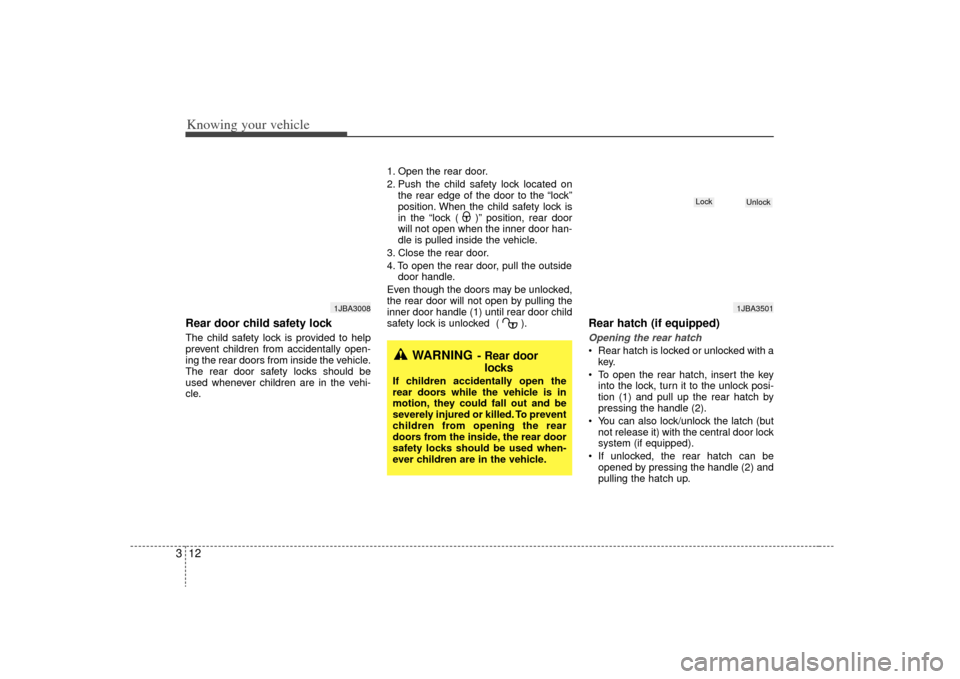
Knowing your vehicle12
3Rear door child safety lockThe child safety lock is provided to help
prevent children from accidentally open-
ing the rear doors from inside the vehicle.
The rear door safety locks should be
used whenever children are in the vehi-
cle. 1. Open the rear door.
2. Push the child safety lock located on
the rear edge of the door to the “lock”
position. When the child safety lock is
in the “lock ( )” position, rear door
will not open when the inner door han-
dle is pulled inside the vehicle.
3. Close the rear door.
4. To open the rear door, pull the outside door handle.
Even though the doors may be unlocked,
the rear door will not open by pulling the
inner door handle (1) until rear door child
safety lock is unlocked ( ).
Rear hatch (if equipped)Opening the rear hatch Rear hatch is locked or unlocked with a key.
To open the rear hatch, insert the key into the lock, turn it to the unlock posi-
tion (1) and pull up the rear hatch by
pressing the handle (2).
You can also lock/unlock the latch (but not release it) with the central door lock
system (if equipped).
If unlocked, the rear hatch can be opened by pressing the handle (2) and
pulling the hatch up.
1JBA3008
WARNING
- Rear doorlocks
If children accidentally open the
rear doors while the vehicle is in
motion, they could fall out and be
severely injured or killed. To prevent
children from opening the rear
doors from the inside, the rear door
safety locks should be used when-
ever children are in the vehicle.
1JBA3501
Lock
Unlock
Page 22 of 219

313
Knowing your vehicle
Cargo area lamp (if equipped)The cargo area lamp turns on when the
rear hatch is opened. It remains on until
the rear hatch is securely closed.✽ ✽NOTICEMake sure to close the rear hatch
securely. If it remains open while engine
is not running, it may cause battery dis-
charge because cargo area lamp
remains on.
CAUTION -
Rear hatch
The rear hatch swings upward.
Make sure no objects or people are near the rear of the vehicle whenopening the rear hatch.
WARNING
- Exhaust
fumes
If you drive with the rear hatch
open, you will draw dangerous
exhaust fumes into your vehicle
which can cause serious injury or
death to vehicle occupants.
If you must drive with the rear hatch
open, keep the air vents and all win-
dows open so that additional out-
side air comes into the vehicle.
WARNING
- Rear cargo
area
Occupants should never ride in the
rear cargo area where no restraints
are available. To avoid injury in the
event of an accident or sudden
stops, occupants should always be
properly restrained.
1JBA3520
Page 23 of 219
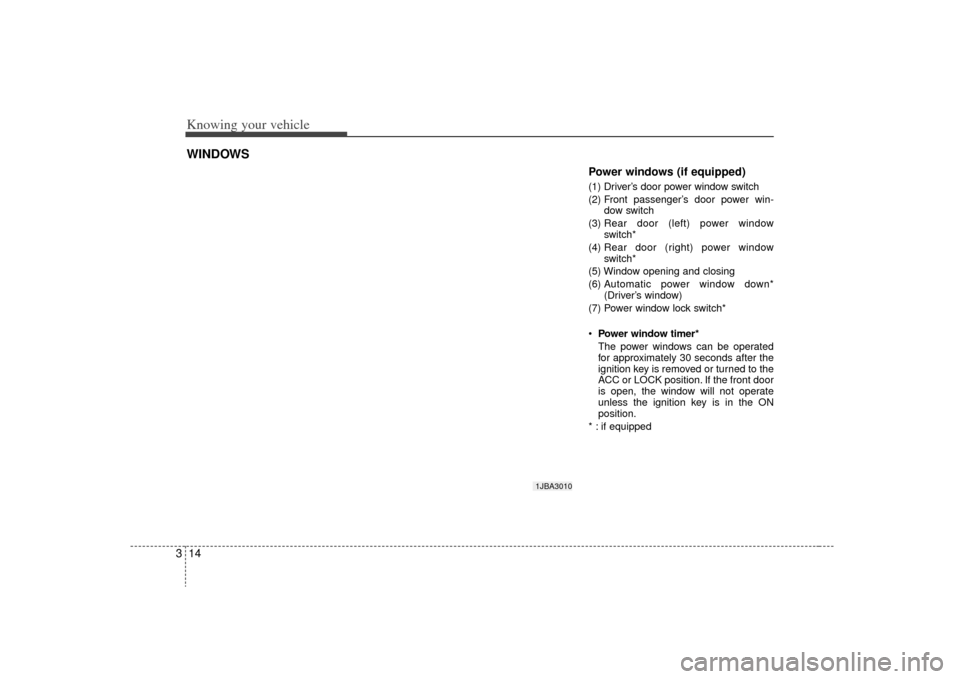
Knowing your vehicle14
3
Power windows (if equipped)(1) Driver’s door power window switch
(2) Front passenger’s door power win-
dow switch
(3) Rear door (left) power window
switch*
(4) Rear door (right) power window
switch*
(5) Window opening and closing
(6) A utomatic power window down*
(Driver’s window)
(7) Power window lock switch*
Power window timer*
The power windows can be operated
for approximately 30 seconds after the
ignition key is removed or turned to the
ACC or LOCK position. If the front door
is open, the window will not operate
unless the ignition key is in the ON
position.
* : if equipped
WINDOWS
1JBA3010
Page 24 of 219
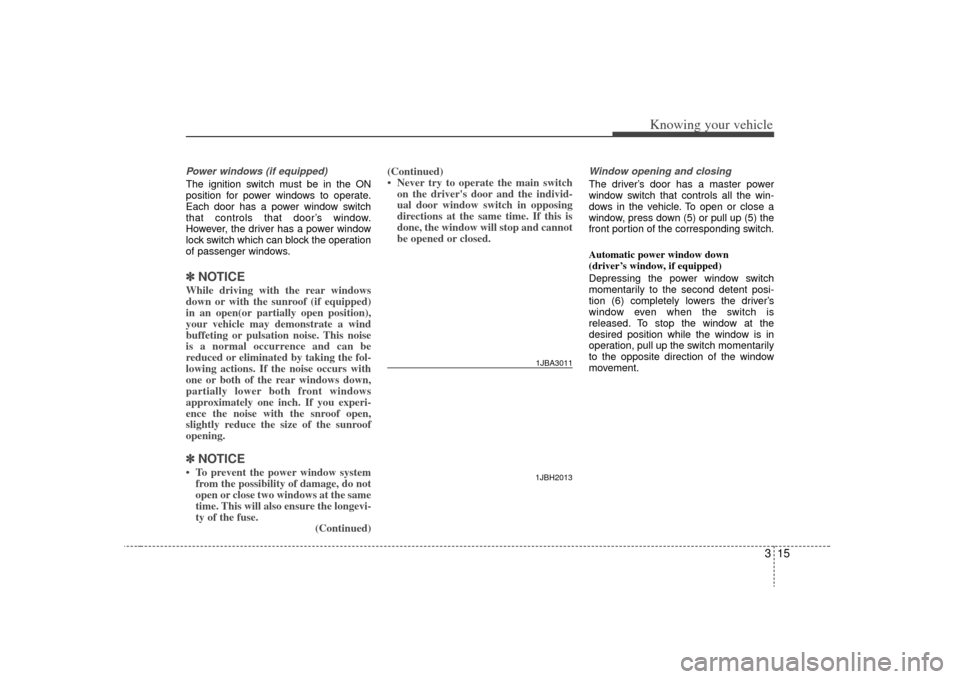
315
Knowing your vehicle
Power windows (if equipped)The ignition switch must be in the ON
position for power windows to operate.
Each door has a power window switch
that controls that door’s window.
However, the driver has a power window
lock switch which can block the operation
of passenger windows.✽ ✽NOTICEWhile driving with the rear windows
down or with the sunroof (if equipped)
in an open(or partially open position),
your vehicle may demonstrate a wind
buffeting or pulsation noise. This noise
is a normal occurrence and can be
reduced or eliminated by taking the fol-
lowing actions. If the noise occurs with
one or both of the rear windows down,
partially lower both front windows
approximately one inch. If you experi-
ence the noise with the snroof open,
slightly reduce the size of the sunroof
opening.✽ ✽NOTICE• To prevent the power window system
from the possibility of damage, do not
open or close two windows at the same
time. This will also ensure the longevi-
ty of the fuse. (Continued)(Continued)
• Never try to operate the main switch
on the driver's door and the individ-
ual door window switch in opposing
directions at the same time. If this is
done, the window will stop and cannot
be opened or closed.
Window opening and closingThe driver’s door has a master power
window switch that controls all the win-
dows in the vehicle. To open or close a
window, press down (5) or pull up (5) the
front portion of the corresponding switch.
Automatic power window down
(driver’s window, if equipped)
Depressing the power window switch
momentarily to the second detent posi-
tion (6) completely lowers the driver’s
window even when the switch is
released. To stop the window at the
desired position while the window is in
operation, pull up the switch momentarily
to the opposite direction of the window
movement.
1JBH20131JBA3011
Page 25 of 219

Knowing your vehicle16
3Power window lock switch
(if equipped)
The driver can disable the power win-
dow switches on on all passenger
doors by depressing the power window
lock switch located on the driver’s door
to LOCK (pressed).
When the power window lock switch is ON, the driver’s master control
cannot operate the passenger door
power windows either.
Manual windows (if equipped)Use the window crank to open and close
each window.
CAUTION -
Windows
Always double-check to make sure all arms, hands, heads andother obstructions are safely out of the way before closing a win-dow. Serious injury could occur.
Do not allow children to play with the power windows. Keep the dri-ver’s door power window lockswitch in the LOCK position (depressed). Serious injury canresult from unintentional window operation by a child.
Never extend face or arms out- side through the window openingwhile driving.
3FDA2015
OJB028013
Page 26 of 219
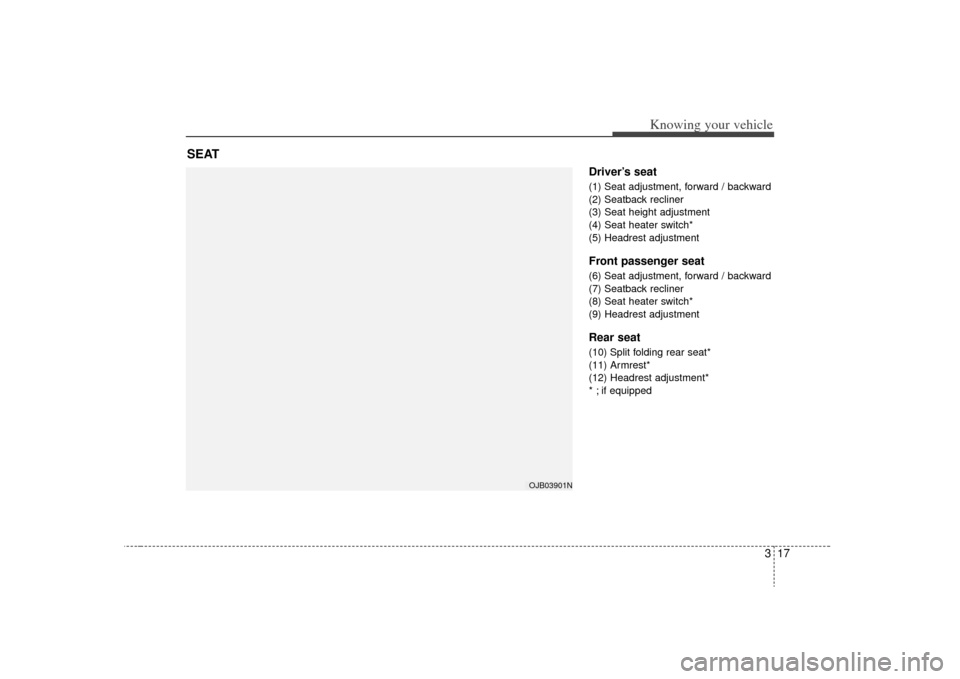
317
Knowing your vehicle
Driver’s seat(1) Seat adjustment, forward / backward
(2) Seatback recliner
(3) Seat height adjustment
(4) Seat heater switch*
(5) Headrest adjustmentFront passenger seat(6) Seat adjustment, forward / backward
(7) Seatback recliner
(8) Seat heater switch*
(9) Headrest adjustment Rear seat(10) Split folding rear seat*
(11) Armrest*
(12) Headrest adjustment*
* ; if equipped
SEAT
OJB03901N
Page 27 of 219
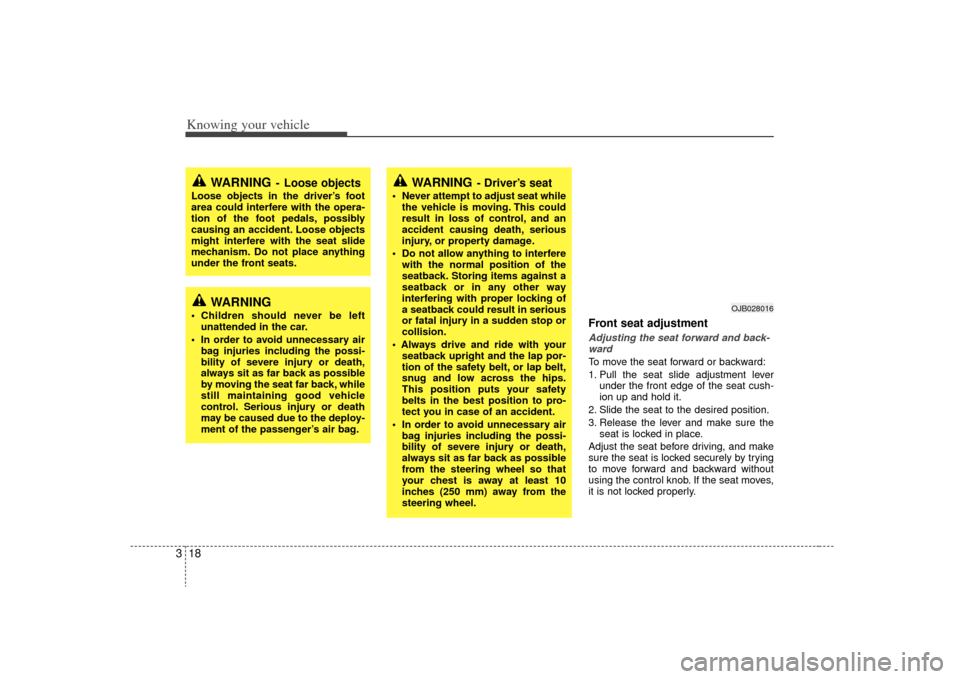
Knowing your vehicle18
3
Front seat adjustmentAdjusting the seat forward and back-
wardTo move the seat forward or backward:
1. Pull the seat slide adjustment lever under the front edge of the seat cush-
ion up and hold it.
2. Slide the seat to the desired position.
3. Release the lever and make sure the seat is locked in place.
Adjust the seat before driving, and make
sure the seat is locked securely by trying
to move forward and backward without
using the control knob. If the seat moves,
it is not locked properly.
WARNING
- Loose objects
Loose objects in the driver’s foot
area could interfere with the opera-
tion of the foot pedals, possibly
causing an accident. Loose objects
might interfere with the seat slide
mechanism. Do not place anything
under the front seats.
WARNING
Children should never be left unattended in the car.
In order to avoid unnecessary air bag injuries including the possi-
bility of severe injury or death,
always sit as far back as possible
by moving the seat far back, while
still maintaining good vehicle
control. Serious injury or death
may be caused due to the deploy-
ment of the passenger’s air bag.
WARNING
- Driver’s seat
Never attempt to adjust seat whilethe vehicle is moving. This could
result in loss of control, and an
accident causing death, serious
injury, or property damage.
Do not allow anything to interfere with the normal position of the
seatback. Storing items against a
seatback or in any other way
interfering with proper locking of
a seatback could result in serious
or fatal injury in a sudden stop or
collision.
seatback upright and the lap por-
tion of the safety belt, or lap belt,
snug and low across the hips.
This position puts your safety
belts in the best position to pro-
tect you in case of an accident.
In order to avoid unnecessary air bag injuries including the possi-
bility of severe injury or death,
always sit as far back as possible
from the steering wheel so that
your chest is away at least 10
inches (250 mm) away from the
steering wheel.
OJB028016
Page 28 of 219
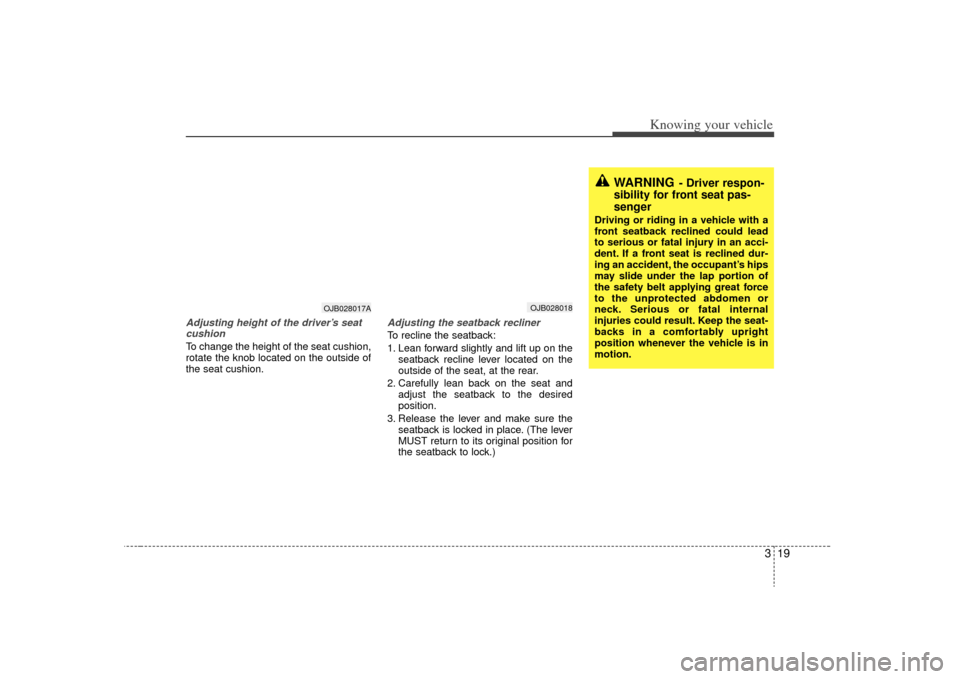
319
Knowing your vehicle
Adjusting height of the driver’s seatcushion To change the height of the seat cushion,
rotate the knob located on the outside of
the seat cushion.
Adjusting the seatback reclinerTo recline the seatback:
1. Lean forward slightly and lift up on the seatback recline lever located on the
outside of the seat, at the rear.
2. Carefully lean back on the seat and adjust the seatback to the desired
position.
3. Release the lever and make sure the seatback is locked in place. (The lever
MUST return to its original position for
the seatback to lock.)
WARNING
- Driver respon-
sibility for front seat pas-
senger
Driving or riding in a vehicle with a
front seatback reclined could lead
to serious or fatal injury in an acci-
dent. If a front seat is reclined dur-
ing an accident, the occupant’s hips
may slide under the lap portion of
the safety belt applying great force
to the unprotected abdomen or
neck. Serious or fatal internal
injuries could result. Keep the seat-
backs in a comfortably upright
position whenever the vehicle is in
motion.
OJB028017A
OJB028018
Page 29 of 219
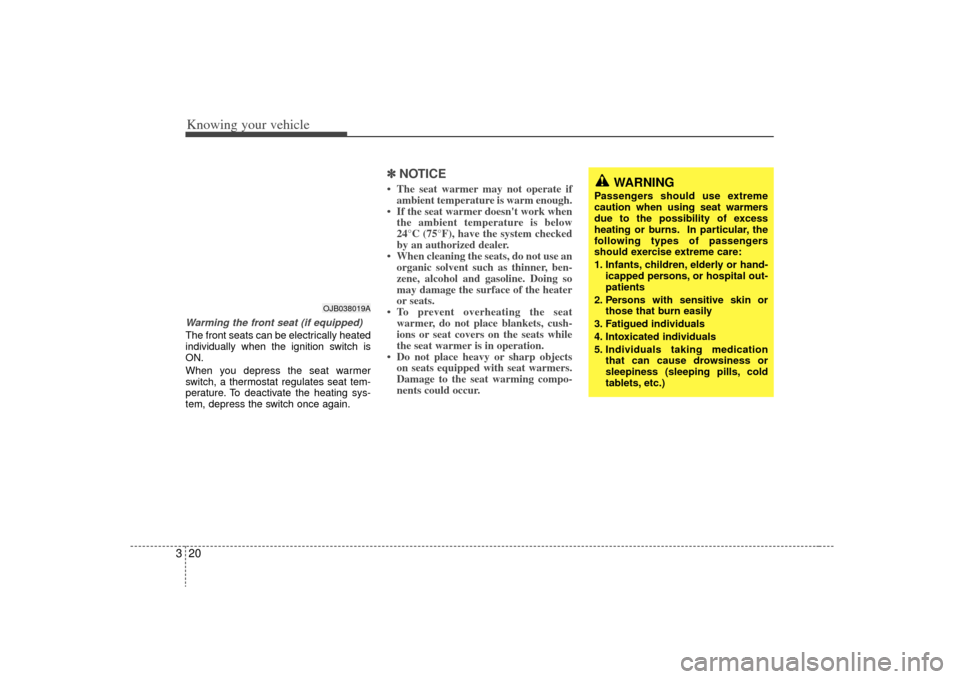
Knowing your vehicle20
3Warming the front seat (if equipped)The front seats can be electrically heated
individually when the ignition switch is
ON.
When you depress the seat warmer
switch, a thermostat regulates seat tem-
perature. To deactivate the heating sys-
tem, depress the switch once again.
✽ ✽
NOTICE• The seat warmer may not operate if
ambient temperature is warm enough.
• If the seat warmer doesn't work when the ambient temperature is below
24°C (75°F), have the system checked
by an authorized dealer.
• When cleaning the seats, do not use an organic solvent such as thinner, ben-
zene, alcohol and gasoline. Doing so
may damage the surface of the heater
or seats.
• To prevent overheating the seat warmer, do not place blankets, cush-
ions or seat covers on the seats while
the seat warmer is in operation.
• Do not place heavy or sharp objects on seats equipped with seat warmers.
Damage to the seat warming compo-
nents could occur.
OJB038019A
WARNING
Passengers should use extreme
caution when using seat warmers
due to the possibility of excess
heating or burns. In particular, the
following types of passengers
should exercise extreme care:
1. Infants, children, elderly or hand-
icapped persons, or hospital out-
patients
2. Persons with sensitive skin or those that burn easily
3. Fatigued individuals
4. Intoxicated individuals
5. Individuals taking medication that can cause drowsiness or
sleepiness (sleeping pills, cold
tablets, etc.)
Page 30 of 219
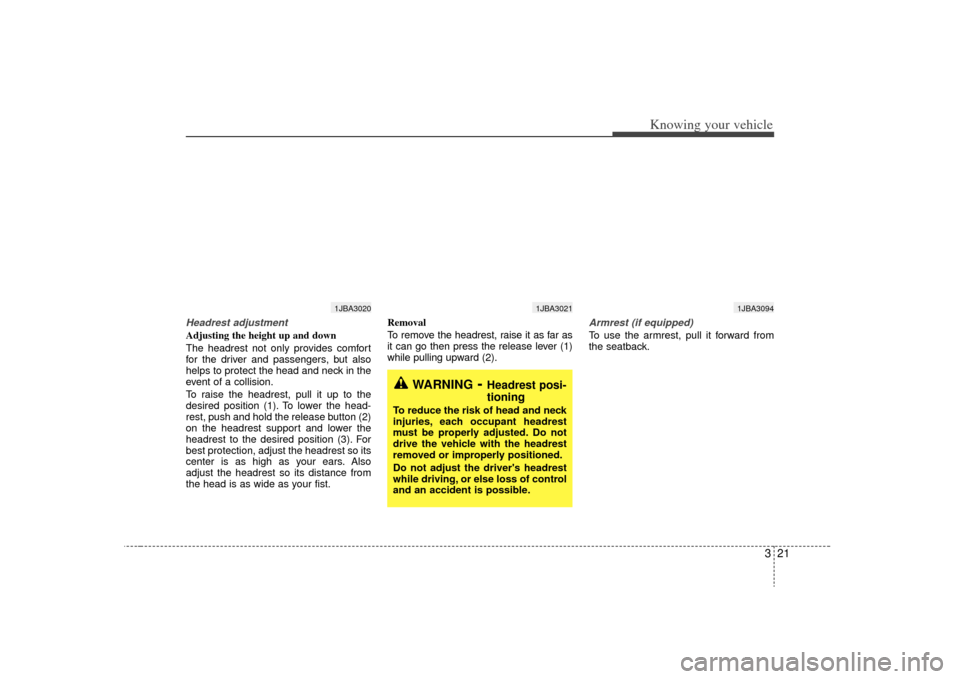
321
Knowing your vehicle
Headrest adjustmentAdjusting the height up and down
The headrest not only provides comfort
for the driver and passengers, but also
helps to protect the head and neck in the
event of a collision.
To raise the headrest, pull it up to the
desired position (1). To lower the head-
rest, push and hold the release button (2)
on the headrest support and lower the
headrest to the desired position (3). For
best protection, adjust the headrest so its
center is as high as your ears. Also
adjust the headrest so its distance from
the head is as wide as your fist.Removal
To remove the headrest, raise it as far as
it can go then press the release lever (1)
while pulling upward (2).
Armrest (if equipped)To use the armrest, pull it forward from
the seatback.
1JBA3020
1JBA3021
1JBA3094
WARNING
- Headrest posi-
tioning
To reduce the risk of head and neck
injuries, each occupant headrest
must be properly adjusted. Do not
drive the vehicle with the headrest
removed or improperly positioned.
Do not adjust the driver's headrest
while driving, or else loss of control
and an accident is possible.